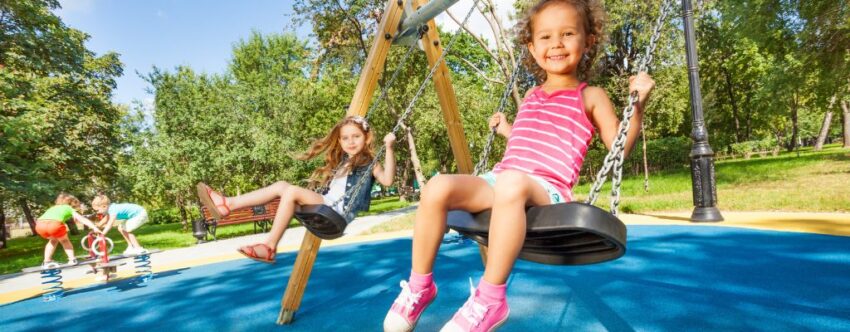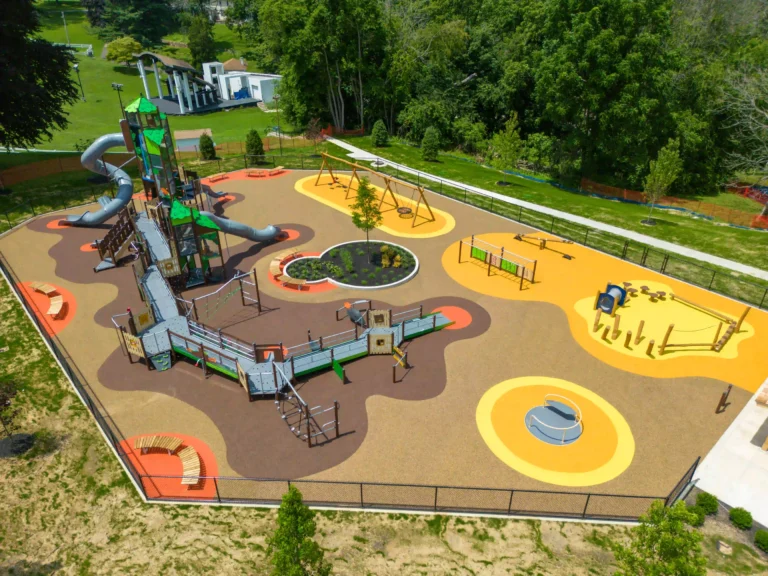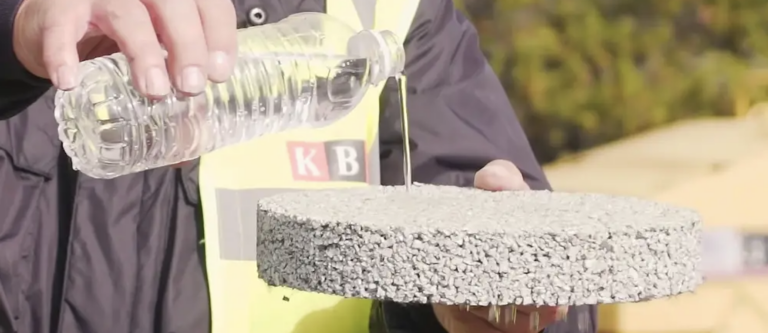Playground surface regulations in Florida encompass various safety standards designed to prevent injuries and ensure a secure environment for children. In this article we will breakdown and explain the regulations around playground surface regulations.

Surface Materials
The selection of surface materials for playgrounds in Florida is guided by safety regulations to minimize the risk of injury. According to the U.S. Consumer Product Safety Commission (CPSC), playgrounds must have protective surfacing materials like wood chips, mulch, sand, or pea gravel that are at least 12 inches deep. These materials are chosen for their ability to cushion falls and reduce the severity of injuries that could occur from playground accidents.
Additionally, mats made of safety-tested rubber or similar materials are also recommended. These surfaces are particularly valued for their durability and effectiveness in impact attenuation. The CPSC guidelines specify that these protective surfaces must extend at least 6 feet in all directions from the edge of the playground equipment. For swings, the required safety surfacing must extend forward and backward, at least twice the height of the bar from which the swing is suspended. This requirement is designed to ensure that in the event of a fall from the highest point of the swing, the impact is sufficiently absorbed by the surfacing material.
These safety measures are crucial for preventing injuries and ensuring that playgrounds remain safe and enjoyable spaces for children. The careful consideration of surfacing materials reflects a commitment to maintaining rigorous safety standards in children’s play areas.

Safety Standards
The Florida Playground Safety Act aims to strengthen playground safety regulations by requiring compliance with the National Playground Safety Guidelines issued by the U.S. Consumer Product Safety Commission (CPSC). This legislation underscores the importance of adhering to rigorous standards to ensure the safety of playground environments.
One key aspect of these standards is the adherence to ASTM International standards, which are globally recognized for defining safety and quality across various materials and products. Specific to playgrounds, ASTM F1292 focuses on the impact attenuation of surfacing materials. This standard assesses how well surfaces reduce the forces a child experiences when they fall, crucial for preventing serious injuries.
Additionally, ASTM F1951 targets the accessibility of surface systems under and around playground equipment. This standard ensures that playgrounds are accessible to children with disabilities, promoting inclusivity by requiring surfaces that can accommodate mobility devices like wheelchairs without compromising safety.
These standards are part of a broader framework intended to reduce injuries and fatalities associated with playground equipment by ensuring all materials and designs meet high safety and accessibility criteria. The enforcement of these guidelines helps create safer recreational environments where children are protected from potential hazards associated with inadequate surfacing and equipment design.
Installation and Maintenance
Proper installation and regular maintenance are fundamental to ensuring the safety and longevity of playground surfaces. Installation begins with meticulous base preparation, which is crucial for supporting the surface materials and ensuring they perform as expected. This preparation typically involves leveling the area and ensuring that drainage is adequate to prevent water accumulation, which can degrade surface materials and create hazardous conditions.
Utilizing the correct barriers, such as geotextile fabrics under loose-fill materials, is essential to prevent the mixing of the playground surface with underlying dirt or sand. These barriers also aid in maintaining the integrity and depth of the safety surfacing, which is critical for effective impact attenuation.
Regular maintenance is equally important and involves routine inspections and adjustments to the playground surfacing. This includes replenishing or redistributing loose-fill materials like sand, wood chips, or rubber mulch to ensure consistent depth and coverage, particularly in high-traffic areas like under swings or at slide exits where material is likely to be displaced. Periodic checks are also necessary to look for and remove any foreign objects or debris that can compromise safety. Additionally, for bonded surfaces like poured-in-place rubber, maintenance may involve checking for wear or tears and repairing these issues promptly to maintain the surface’s shock-absorbing properties.
Adhering to these practices helps extend the lifespan of playground surfaces and ensures they continue to provide safe play environments for children. For more detailed guidance on proper installation and maintenance of playground surfaces, resources are available through playground safety experts and industry standards.
Takeaway
Ensuring the safety and accessibility of playgrounds in Florida requires adherence to rigorous standards and guidelines established by both state and federal entities. The Florida Playground Safety Act emphasizes the importance of complying with National Playground Safety Guidelines from the CPSC and ASTM International standards, such as ASTM F1292 and ASTM F1951, which focus on impact attenuation and accessibility of surface systems, respectively. Proper installation and diligent maintenance are crucial for preserving the integrity and safety of playground surfaces. This involves careful base preparation, using appropriate barriers, and conducting regular safety checks. By implementing these practices, playgrounds can provide a safe and inclusive environment where children of all abilities can play and explore.



